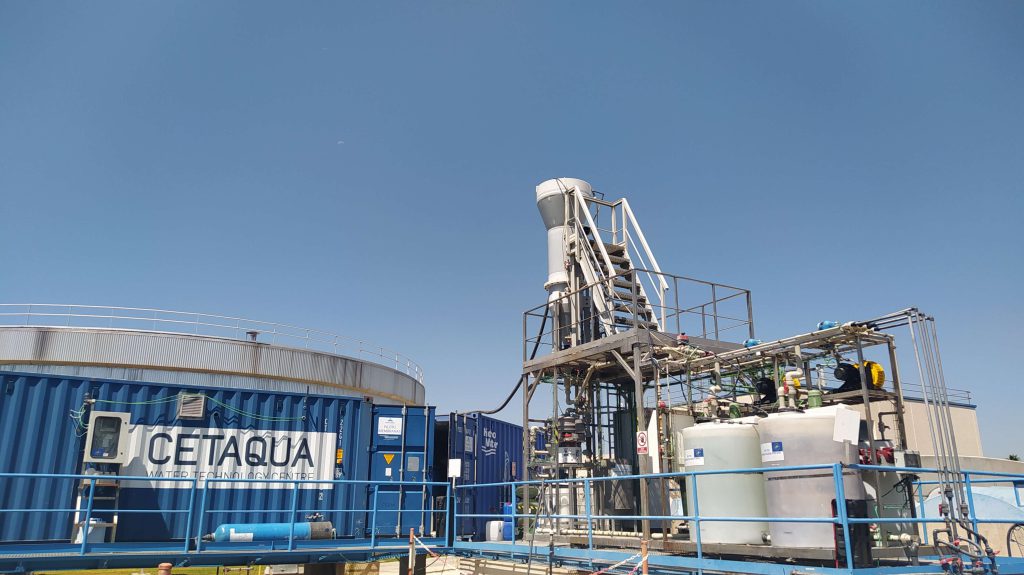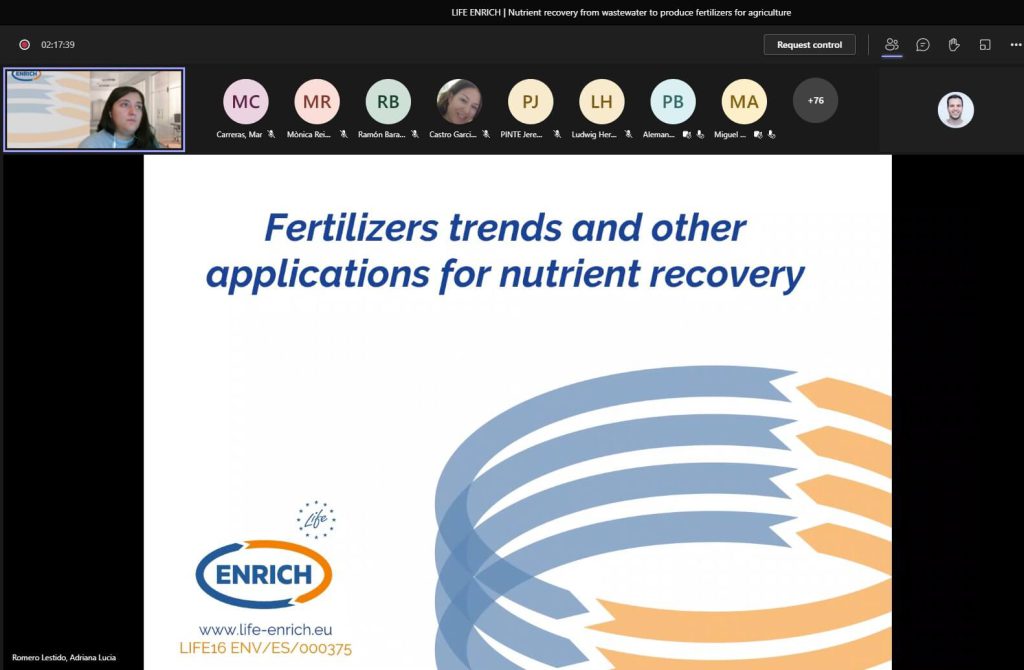News


The LIFE ENRICH project, which started in September 2017 has ended last November 30 with the celebration of the online event “Nutrient recovery from wastewater to produce fertilizers for agriculture”. The meeting covered several topics related to nutrient recovery from wastewater and its use as fertilizer, with a special focus on technical, legislative and commercial aspects, as well as the future of nutrient recovery.
During the first half of the event, the partners of the LIFE ENRICH project presented the results obtained after almost four years of research. This initiative seeks to promote a new circular economy model in wastewater treatment, turning wastewater treatment plants into biofactories, i.e., resource-generating facilities. To achieve this, it has demonstrated the technical, environmental and economic viability of a solution for recovering nutrients from wastewater and valorizing them as fertilizers. In addition, these fertilizers have been tested in trials with greenhouse and field crops and have demonstrated their viability as an alternative to conventional fertilizers in terms of agronomic properties.
LIFE ENRICH has analyzed the entire value chain, from the recovery of nutrients in wastewater treatment plants to the use of fertilizers in the field, and has developed two sustainable business models, one applied to the technological solution and the other to the fertilizers produced. Likewise, the business plan defined contemplates the possibility of obtaining economic profitability in the technological implementation and the sale of fertilizers under certain scenarios. Once finalized, the LIFE ENRICH solution is ready to be replicated in other wastewater treatment plants and the business models adapted to other countries of the European Union, taking into account various technical particularities in the facilities and the legislative context or the agricultural activity in each territory, among other factors.
The future of fertilizers will be circular, according to experts
The event was also attended by Nadia Lamhandaz, head of projects at the European Commission’s CINEA agency, who presented the new funding opportunities of the LIFE program, the European Union’s funding instrument for the environment and climate action. On the other hand, Jérémy Pinte, policy officer for classification, labeling and packaging of substances and mixtures and fertilizer products at the European Commission (DG GROW), highlighted the agency’s efforts to adapt and implement the current regulation that includes struvite as a fertilizer. These changes will be reflected in the new EU Fertilising Products Regulation (FPR) (EU) 2019/1009 that will come into force in July 2022. In this way, technologies and processes such as those developed under LIFE ENRICH will help foster the circular economy and boost synergies between the water and agriculture sectors.
Regarding the future of nutrient recovery, Ludwig Hermann, president of the European Sustainable Phosphorus Platform (ESPP) remarked that Europe is enabling this transition towards the use of recycled fertilizers. In this regard, he stressed that “this shift is a challenge for farmers and the fertilizer production industry, as it is necessary to maintain current yields while reducing emissions and nutrient losses in production processes and agricultural practices. To achieve this, different sectors, such as water and agriculture, need to cooperate to close nutrient cycles. In the same line, Cetaqua introduced the H2020 Walnut project, an initiative with a strong link to LIFE ENRICH that will allow improving the performance of the fertilizers developed, with biological base and recovered nutrients.
Finally, Jordi Julià, head of the technical area of the Agricultural Cooperative Progrés-Garbí (Malgrat de Mar, Spain) offered the point of view of farmers and agricultural cooperatives, the end users of fertilizers. During his intervention, he highlighted the importance of carrying out initiatives such as LIFE ENRICH, which bring us closer to a more sustainable agriculture based on circular economy.
LIFE ENRICH, boosting synergies between the water and agriculture sectors
Cetaqua has led the LIFE ENRICH project and has participated as a technological reference for the processes of transformation of recovered nitrogen and phosphorus into fertilizers. This initiative, co-financed by the LIFE program of the European Commission, has also counted with the participation of the Instituto de Investigación y Tecnología Agroalimentaria (IRTA), in charge of the agronomic tests; Aigües del Segarra Garrigues (ASG), the private company in charge of running, operating and maintaining the irrigation distribution network of the Segarra-Garrigues system, as the end user of the products; the Empresa Municipal de Aguas y Saneamiento de Murcia (EMUASA), responsible for the operation of the pilot at the Murcia East WWTP, the Universitat Politècnica de Catalunya (UPC) as experts in nitrogen recovery and the Universitat Politècnica de València (UPV), as experts in phosphorus recovery.